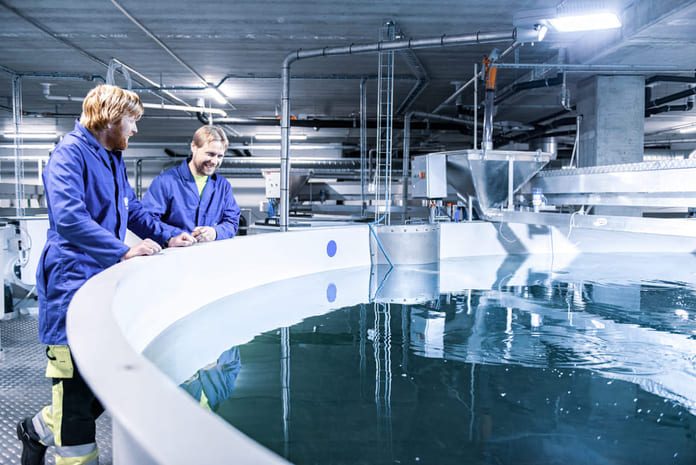With the pace at which the construction of new land-based salmon farms is progressing, one can get the impression that there are few challenges that remain when it comes to RAS technology. For the technology provider Krüger Kaldnes, however, the increasing number and size of the facilities creates incentives to solve challenges that must be solved in order for the facilities to become sustainable.
Recirculating aquaculture systems (RAS) has been around for decades.
“For salmon in Norway, it really took off only 10-12 years ago, and now almost all new projects for smolts and post-smolts in Norway are RAS based”, said Dr. Frederic Gaumet, business development manager in aquaculture for aquaculture systems (RAS) specialist Krüger Kaldnes.
The development is driven towards bigger facilities, bigger tanks and bigger fish. With that, new challenges are constantly emerging. Krüger Kaldnes is an active partner that is involved in several research topics in CtrlAQUA, and that gave rise to a business PhD within biofilter technology in 2021. However, increased energy efficiency is one necessary step towards a fully sustainable industry, and in their partnership with CtrlAQUA, they address this issue:
“When we push the limits, the interface of RAS technology with environment is an inevitable topic. It is time to do something about energy savings to be truly sustainable,” said Gaumet.
What can be done
Energy is second largest cost in a RAS facility after feed. Much energy is used on pumping water. In addition, energy is wasted when removing carbon dioxide (CO2) from the used water, which is done in a carbon dioxide degassing unit. There has been a lot of research but only little development in the industry on reducing energy use in these units through the decades of RAS, and it is now a goal in CtrlAQUA.
[factbox]
Technologies for stripping CO2 in RAS have poorly evolved in the last decade. Today CO2 is removed by using gas exchange chambers where water is put into contact with large quantities of air, so CO2 can transfer from the water to the air phase. This CO2-rich air is sent out of the building using electric fans. Here Krüger Kaldnes see great opportunities to improve control over energy. Keywords are pH buffer management and fan automation.
Develops a carbonate toolbox
To get to the point where energy is saved, there is a need for a model – a toolbox – to manage the carbonate efficiently:
“Some of the systems are running in brackish water. When playing with salinity you challenge the balance in the system, so everything needs to be controlled. To gain this control, we have been working closely with scientists in Nofima and discussing the need for estimating CO2 development based on biomass, feed, pH and other factors” said Gaumet.
Nofima and Krüger Kaldnes are developing the toolbox. The scientists have already done the theoretical work on potential energy savings and carbonate modelling. Now these models will be validated in practice to make a digital carbonate toolbox to be used in energy management for salmon farmers with RAS.
Can save 20 percent energy
Gaumet think there is probably room for saving up to 15-20 per-cent of the energy used in a RAS facility as a whole, by optimizing the use of energy sources, consumption and by recovering energy from water and air.

“We need to see the system as a whole loop, if we shall succeed in saving energy”, said Gaumet.
Need RAS competence in the industry
To operate and develop these systems further, the industry needs more trained people, as these are big and complex systems.
“That’s why we are so eager to use CtrlAQUA as an arena to increase the knowledge of our employees at all levels. We have great advantage of participating in the discussions with the professionals in the CtrlAQUA consortium and combining the knowledge with the work we do. What makes this consortium very rich, is that there is very good representation of the leading companies in the industry, and research institutes that have RAS test facilities”, said Gaumet.
Gaumet stated that they don’t have a fixed product. It’s a dynamic process where they keep learning on how to optimise. “We can really approach a lot of topics, and the results can be used directly by the industry,” he said.
In the next facility that Krüger Kaldnes designs, Gaumet is certain that the latest knowledge from CtrlAQUA will be included and have an impact.

